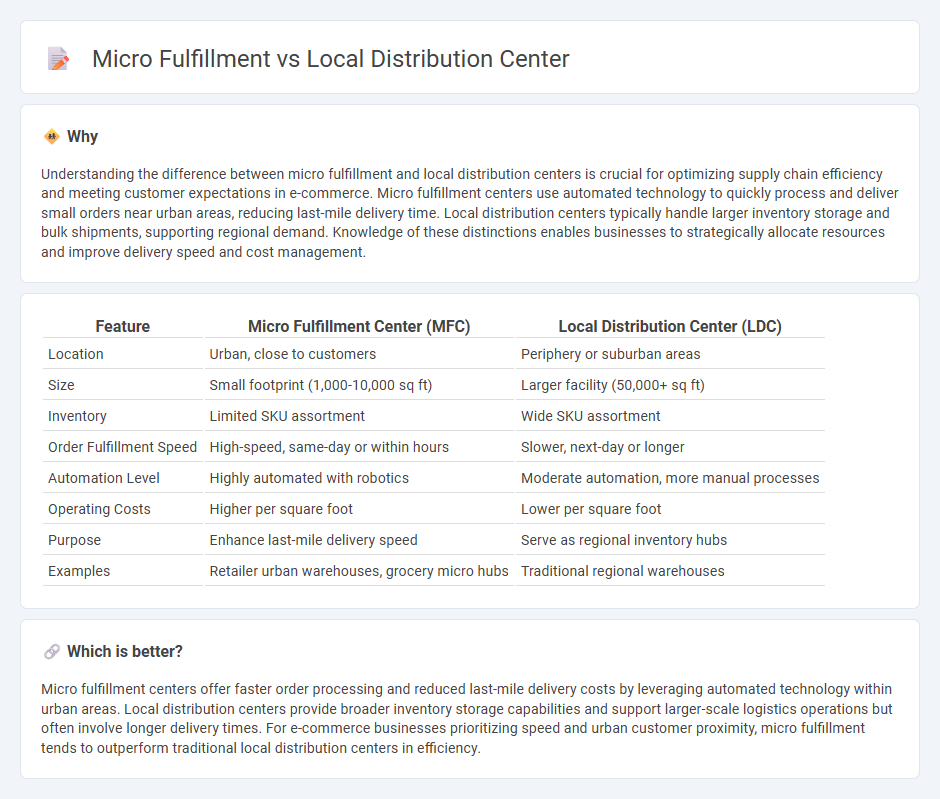
Micro fulfillment centers use automated systems to quickly process online orders close to customers, reducing delivery times and last-mile costs. Local distribution centers serve as larger hubs that store inventory and distribute products across broader regions, focusing on bulk storage and efficient supply chain management. Explore the benefits and differences between micro fulfillment and local distribution centers to optimize your commerce strategy.
Why it is important
Understanding the difference between micro fulfillment and local distribution centers is crucial for optimizing supply chain efficiency and meeting customer expectations in e-commerce. Micro fulfillment centers use automated technology to quickly process and deliver small orders near urban areas, reducing last-mile delivery time. Local distribution centers typically handle larger inventory storage and bulk shipments, supporting regional demand. Knowledge of these distinctions enables businesses to strategically allocate resources and improve delivery speed and cost management.
Comparison Table
| Feature | Micro Fulfillment Center (MFC) | Local Distribution Center (LDC) |
|---|---|---|
| Location | Urban, close to customers | Periphery or suburban areas |
| Size | Small footprint (1,000-10,000 sq ft) | Larger facility (50,000+ sq ft) |
| Inventory | Limited SKU assortment | Wide SKU assortment |
| Order Fulfillment Speed | High-speed, same-day or within hours | Slower, next-day or longer |
| Automation Level | Highly automated with robotics | Moderate automation, more manual processes |
| Operating Costs | Higher per square foot | Lower per square foot |
| Purpose | Enhance last-mile delivery speed | Serve as regional inventory hubs |
| Examples | Retailer urban warehouses, grocery micro hubs | Traditional regional warehouses |
Which is better?
Micro fulfillment centers offer faster order processing and reduced last-mile delivery costs by leveraging automated technology within urban areas. Local distribution centers provide broader inventory storage capabilities and support larger-scale logistics operations but often involve longer delivery times. For e-commerce businesses prioritizing speed and urban customer proximity, micro fulfillment tends to outperform traditional local distribution centers in efficiency.
Connection
Micro fulfillment centers enhance local distribution by enabling rapid order processing close to customers, reducing delivery times and last-mile logistics costs. These compact facilities use automation and inventory optimization techniques to efficiently manage stock, directly supporting local distribution centers in meeting demand spikes. Effective integration between micro fulfillment centers and local distribution hubs improves overall supply chain responsiveness and customer satisfaction in commerce.
Key Terms
Inventory Management
Local distribution centers optimize inventory management by storing larger quantities of stock closer to demand hubs, reducing lead times and enhancing order accuracy. Micro fulfillment centers use automation and AI-driven systems to manage smaller, high-turnover inventories rapidly within urban or store environments, improving same-day delivery capabilities. Explore the differences in inventory strategies to understand their impact on supply chain efficiency.
Order Fulfillment Speed
Local distribution centers streamline order fulfillment by storing inventory strategically closer to customers, significantly reducing shipping times and enabling faster delivery. Micro fulfillment centers enhance speed by utilizing automated systems and robotics within urban or store-adjacent locations, optimizing pick-and-pack efficiency for same-day or next-day delivery. Explore detailed comparisons to understand which fulfillment model best accelerates your order processing.
Last-Mile Delivery
Local distribution centers optimize last-mile delivery by consolidating inventory closer to urban areas, reducing transit times and transportation costs. Micro fulfillment centers use automation within small-scale facilities situated inside or near retail stores, enabling rapid order processing and same-day delivery. Explore how these models reshape last-mile efficiency for enhanced customer satisfaction.
Source and External Links
Distribution Center Benefits and Key Processes Explained - ShipBob - A local distribution center functions as a hub that receives inventory, stores it efficiently for picking and packing, and supports fast fulfillment and shipping to customers, often enabling same-day shipment to reduce transit times and shipping costs.
Warehouse and Distributions Centers - HD Supply - Local distribution centers deliver products quickly, often with next-day delivery capabilities, and allow for easy product pick-up to ensure businesses can stay focused and well-stocked.
USPS Distribution Center - US Global Mail - A USPS local distribution center acts as a regional hub that sorts and organizes mail and packages efficiently, speeding delivery and ensuring reliability within the postal network.
 dowidth.com
dowidth.com